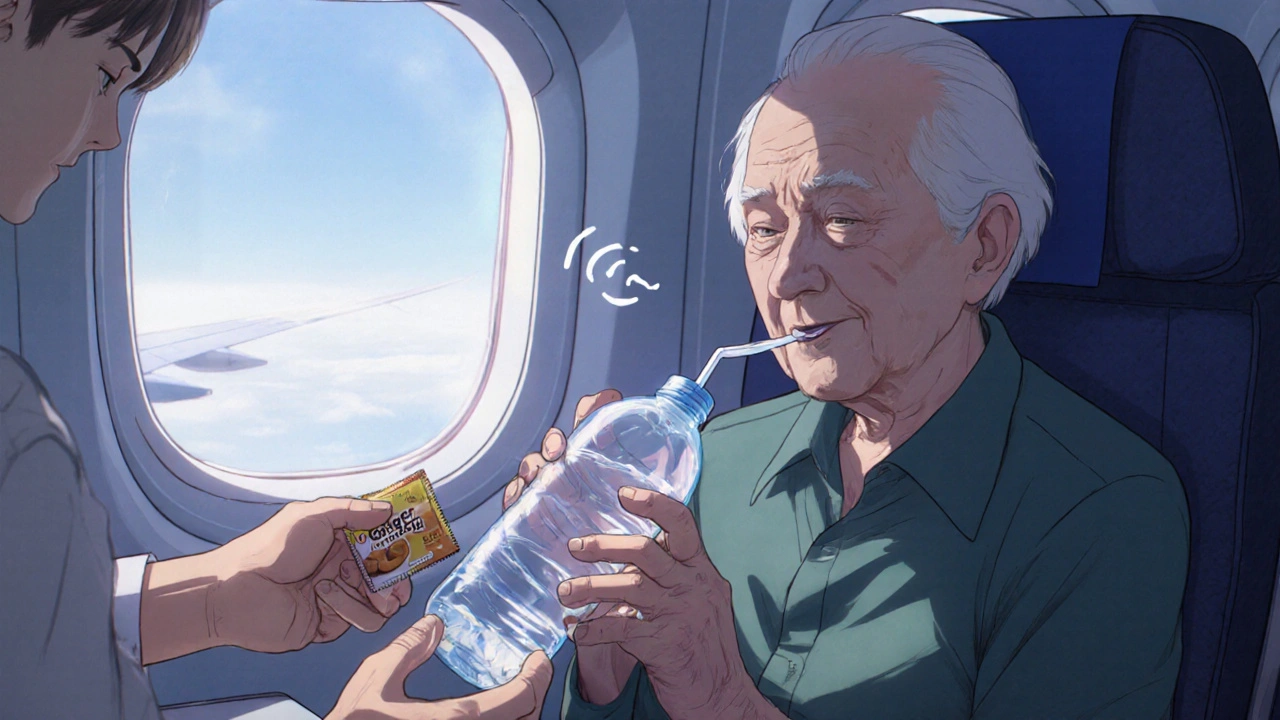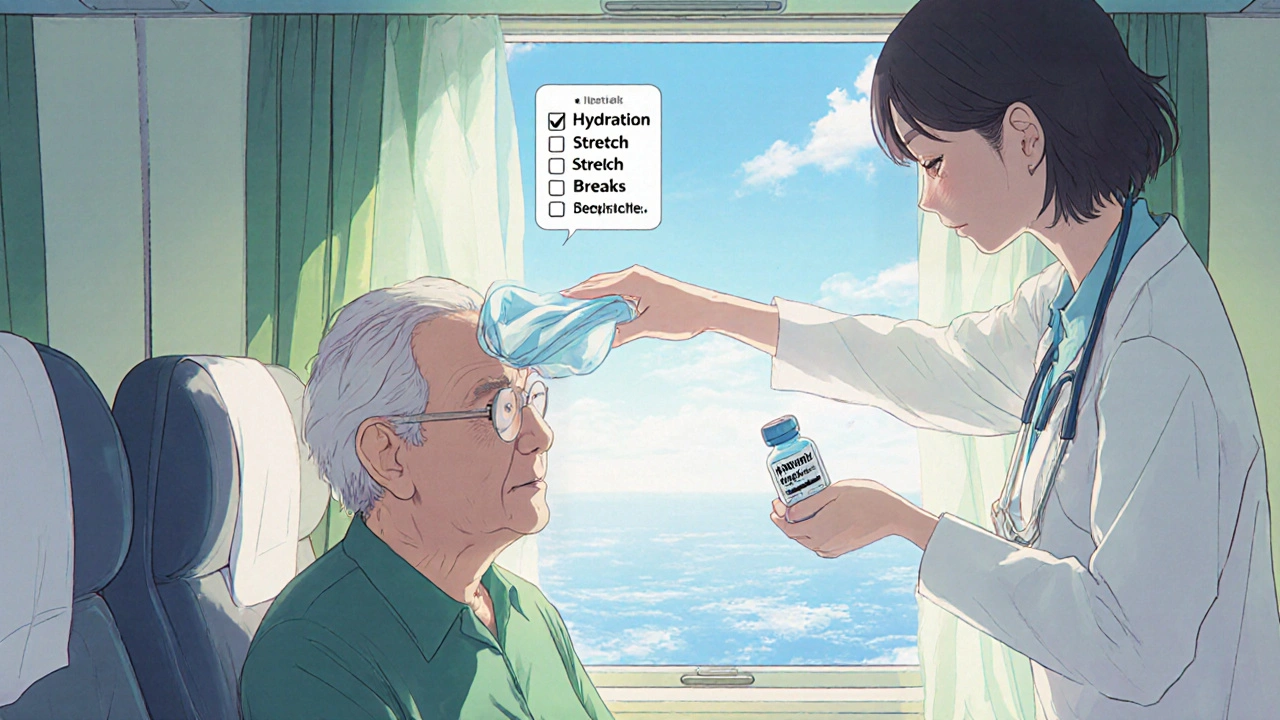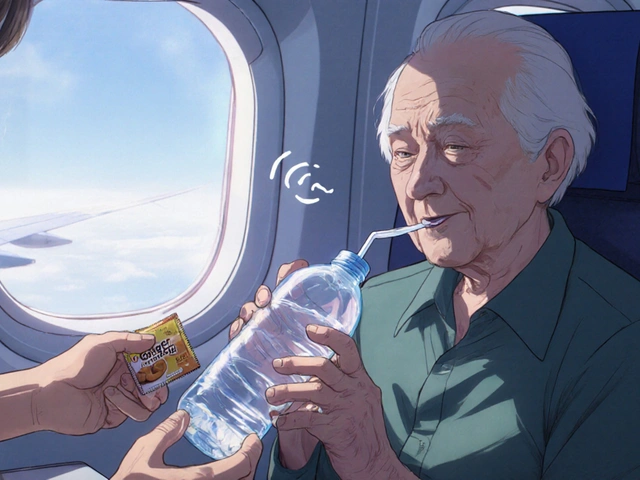Travel Sickness in the Elderly: Essential Caregiver Tips

Elderly Travel Sickness Medication Selector
Medication Selection Tool
This tool helps you select the most appropriate travel sickness medication for an elderly person based on their health conditions and current medications. It considers key factors such as blood pressure, balance issues, and potential drug interactions.
When an older adult feels queasy on a plane, train, or car, that’s Travel Sickness a form of motion‑induced nausea, dizziness, and vomiting that can affect anyone but often worsens with age. Caring for seniors who experience this can feel overwhelming, but a handful of practical steps can keep the journey comfortable and safe.
Why Travel Sickness Hits Older Travelers Harder
Age‑related changes in the inner ear, slower metabolism of medications, and chronic health conditions all raise the odds of feeling ill while on the move. In addition, many seniors take Medication prescriptions for blood pressure, pain, or sleep that can interact with motion‑induced nausea. Even a simple ride on a ferry can trigger the same upset that a roller coaster would cause a teenager.
Common Triggers to Keep an Eye On
- Sudden changes in direction - especially on winding roads or rough seas.
- Long periods of sitting without fresh air.
- Strong smells from food, perfume, or diesel fumes.
- Dehydration - seniors often forget to drink enough fluids.
Identifying which of these factors are present helps you target the right solution before the queasy feeling starts.
Assessing the Risk Before You Pack
Take a quick health screen with the older traveler. Ask about recent changes in Blood Pressure readings, balance issues, and any history of motion sickness. Note any new prescriptions that could amplify nausea, such as opioids or certain antibiotics.
Write down these details on a one‑page checklist so the information is easy to share with any medical professional you might meet on the road.
Non‑Pharmacologic Strategies That Work
Before heading to the pharmacy, try these low‑cost, low‑risk options:
- Stay Hydrated: Offer a sip of water every 15 minutes. Use a reusable bottle with a straw to make drinking effortless.
- Ginger fresh ginger, ginger tea, or certified ginger chews that have been shown to reduce nausea in clinical studies can be a soothing snack. A small piece of candied ginger (about 5 g) works well.
- Choose seats over the wings on an aircraft or mid‑boat on a vessel - these spots experience less motion.
- Encourage gentle breathing: inhale slowly through the nose, hold for three seconds, exhale through the mouth.
- Limit heavy meals and alcohol 2‑3 hours before departure.

Medication Options and How to Choose
If non‑drug measures aren’t enough, a caregiver can discuss safe anti‑nausea options with the senior’s doctor. Below is a quick comparison of the most common choices.
| Medication | Typical Dose | Onset | Common Side Effects | Key Considerations for Seniors |
|---|---|---|---|---|
| Dimenhydrinate (Dramamine) | 50 mg PO 30 min before travel | 15‑30 min | Drowsiness, dry mouth | Use low dose; may worsen balance issues. |
| Meclizine (Bonine) | 25 mg PO 1 hour before travel | 1‑2 hr | Drowsiness, blurred vision | Longer‑acting; safer for those with glaucoma. |
| Ginger tablets (standardized 250 mg) | 2 tablets PO 30 min before travel | 30‑60 min | Rare heartburn | Natural option; minimal drug interactions. |
| Scopolamine patch (Transderm Scop) | 1 mg patch applied behind ear 4 hr before travel | 4‑6 hr | Dry mouth, blurred vision, confusion | Use only if doctor approves; avoid in dementia. |
Always start with the lowest effective dose and monitor for drowsiness, especially if the senior will need to navigate airports or stairs.
Preparing the Trip: A Caregiver’s Packing List
- Travel‑size water bottle and electrolyte packets.
- Pre‑packaged ginger chews or fresh ginger slices.
- Any prescribed anti‑nausea medication in clearly labeled containers.
- Comfortable clothing with easy‑access pockets for meds.
- Copy of the senior’s medication list, allergies, and emergency contacts.
- Documentation for Travel Insurance that covers medical emergencies and trip interruption for older travelers.
During the Journey: Real‑Time Tips
- Encourage the senior to look at the horizon or a fixed point; visual stabilization can lessen inner‑ear confusion.
- Keep the cabin temperature cool and well‑ventilated. Warm, stuffy air often worsens nausea.
- Do a quick “stretch break” every hour - simple neck rolls and shoulder shrugs can improve circulation.
- If symptoms start, have the anti‑nausea medication ready and take it at the first sign of queasiness.
- Use a cold compress on the forehead or the back of the neck - it can calm the vestibular system.

Post‑Travel Care and When to Seek Help
After arrival, check the senior’s hydration status: look for dry mouth, reduced urine output, or dizziness when standing. If nausea persists longer than 24 hours, or if there’s vomiting with blood, contact a healthcare provider immediately.
Document any new triggers encountered during the trip, so future travel plans can be adjusted accordingly.
Quick Caregiver Checklist
- Confirm health screen and medication list before departure.
- Pack hydration aids, ginger, and prescribed meds.
- Choose optimal seating - wing seat on planes, mid‑deck on ships.
- Start non‑drug measures 30 minutes before travel.
- Take anti‑nausea medication at first sign of queasiness.
- Monitor hydration and mood throughout the journey.
- Record any issues for future trips.
These steps turn a potentially miserable trip into a manageable experience for both the senior and the caregiver.
Frequently Asked Questions
Can I give over‑the‑counter motion‑sickness pills to someone with high blood pressure?
Most OTC options like dimenhydrinate can raise heart rate and interact with beta‑blockers. Always check with the prescribing doctor; meclizine is often safer for hypertensive seniors.
Is ginger safe for anyone on blood thinners?
In typical culinary amounts, ginger poses little risk, but high‑dose supplements can affect clotting. Stick to small chews (5 g) and confirm with the doctor if the senior uses warfarin or similar drugs.
How long before a flight should I give a prescription anti‑nausea patch?
Scopolamine patches should be applied at least four hours before take‑off to reach full effectiveness. Remove the patch after the flight to avoid lingering dry‑mouth side effects.
Do I need special seating for a wheelchair‑bound senior on a cruise?
Yes. Request a cabin on a deck with easy elevator access and a location near the dining rooms. Many cruise lines label these as “mobility‑friendly cabins.”
What’s the best way to stay hydrated on a long bus ride?
Carry a spill‑proof bottle and sip small amounts every 10‑15 minutes. Adding a pinch of salt or an electrolyte tablet can help retain fluids longer.



Madhav Dasari
Wow, the journey can feel like an emotional roller‑coaster for our elders, but a caring hand makes all the difference.
Think of the water bottle as a tiny lifeline, offering a sip every few minutes to keep dehydration at bay.
Ginger isn’t just a kitchen spice – a few chews can calm the queasy feeling like a soothing lullaby.
And remember, sitting over the wing or mid‑deck is like finding the sweet spot on a seesaw, cutting down the motion that rocks the inner ear.
With a little planning, you turn a stressful trip into a smooth sailing adventure for both of you.
DHARMENDER BHATHAVAR
Prior to departure, review the senior’s medication list for potential interactions with antihistamines.
Kevin Sheehan
Motion‑induced nausea is a physiological response that can be mitigated without immediate resort to prescription drugs.
Encourage the elder to focus on a distant fixed point, which helps the vestibular system recalibrate.
When possible, schedule travel during times of day when the senior feels most alert, reducing the likelihood of dizziness.
Monitoring heart rate during travel can also reveal if a chosen anti‑nausea agent is causing undue strain.
Jay Kay
Even the best seat choice won’t help if the senior is already dehydrated.
A dry mouth is a warning sign, so keep water handy.
Don’t forget to pack the ginger chews – they’re cheap and work well.
Jameson The Owl
Traveling with an older adult requires foresight and a meticulous checklist that accounts for every possible trigger of motion sickness the elderly are prone to encounter the first step is to verify that all current prescriptions have been reviewed by a healthcare professional to rule out any adverse interactions with over‑the‑counter anti‑nausea remedies the second step involves selecting seating that minimizes motion such as a seat over the wing on an airplane or a mid‑deck cabin on a ship the third step is to ensure constant hydration by offering a sip of water at regular intervals the fourth step includes incorporating ginger in any form whether it be tea chew or candied pieces as ginger has been shown to reduce nausea the fifth step is to avoid heavy meals and alcohol several hours before departure the sixth step suggests a simple breathing exercise inhaling through the nose holding briefly and exhaling through the mouth to calm the inner ear the seventh step recommends a quick stretch or neck roll every hour to maintain circulation the eighth step involves having a cold compress ready to place on the forehead if queasiness begins the ninth step is to keep a written record of any symptoms experienced during the trip for future reference the tenth step recommends informing travel companions of the senior’s needs so they can offer assistance the eleventh step is to pack all medications in clearly labeled containers the twelfth step includes bringing an emergency contact list and insurance information the thirteenth step advises checking the cabin temperature to keep it cool and well‑ventilated the final step reminds caregivers to stay calm because anxiety can amplify nausea in the elderly
Rakhi Kasana
The checklist you described is thorough and gives caregivers a clear roadmap to follow, making the travel experience less daunting for both parties.
Sarah Unrath
i think its also important to have a spare bag for extra meds just in case you forget something.
James Dean
observing the elder's reaction during the first half hour can tell a lot about how they will handle the rest of the trip
Monika Bozkurt
From a geriatric pharmacotherapy perspective, the risk–benefit analysis of antihistaminic agents necessitates a comprehensive assessment of anticholinergic burden, especially in polypharmacy contexts where cognitive impairment risk is heightened.